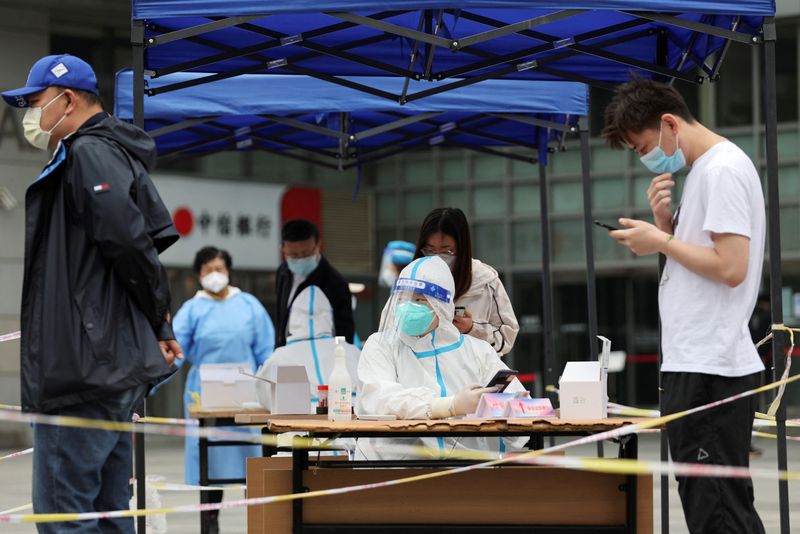
© Reuters. A worker in a protective suit registers information for people lining up at a makeshift nucleic acid testing site during a mass testing for the coronavirus disease (COVID-19) in Chaoyang district of Beijing, China May 10, 2022. REUTERS/TIngshu Wang
2/2
By David Stanway and Martin Quin Pollard
SHANGHAI/BEIJING (Reuters) – Tesla (NASDAQ:) operated its Shanghai plant well below capacity on Tuesday, showing the problems factories there face trying to ramp up output under a tightening COVID lockdown, while China’s capital Beijing kept fighting a small, but elusive outbreak.
Many of the hundreds of companies reopening factories in Shanghai in recent weeks have faced challenges getting production lines back up to speed while keeping workers on-site in a “closed loop” system.
Even if they manage to get everything right, such firms depend on suppliers facing similar challenges.
The latest sign of struggle with increasing output under COVID rules came from Tesla’s Shanghai plant, whose resumption three weeks ago received generous coverage in state media as an example of what can still be achieved despite restrictions.
The U.S. automaker has halted most of its production at the plant due to problems securing parts, according to an internal memo seen by Reuters.
Tesla had planned as late as last week to increase output to pre-lockdown levels by next week.
Among Tesla suppliers facing difficulties is wire harness maker Aptiv (NYSE:) after infections were found among its employees, sources said on Monday.
Videos posted online last week showed dozens of workers at Apple (NASDAQ:) and Tesla supplier Quanta overwhelming hazmat-suited security guards and vaulting over factory gates fearing being trapped inside amid COVID rumours.
COVID curbs in Shanghai, Beijing and dozens of other major population centres and manufacturing hubs across China are taking a heavy toll on the world’s second largest economy, with significant global spillovers on trade and supply chains.
Uncertainty about China’s economic outlook is high, with economists unable to judge with precision when the country could bring COVID under control and for how long and what the final cost is likely to be.
“Growth in China is likely to remain hostage to the course of the pandemic for most of the year,” analysts at Fathom Consulting said in a note.
Chinese markets had another tough day on Tuesday.
Shanghai, a vital centre for commerce, finance and manufacturing for China and beyond with a population of 25 million, was enduring its sixth week of a city-wide lockdown.
The prolonged, ruthlessly-enforced isolation increasingly jars with an outside world which is gradually returning to its pre-COVID way of life, even if cases spread.
China has threatened actions against critics of its “dynamic-zero COVID” policy, which it says aims to “put life first” and prevent the millions of deaths caused by the virus around the globe.
‘CRITICAL PERIOD’
The number of new COVID-19 cases in Shanghai have been falling for almost two weeks, but they remain in the thousands and restrictions were tightening.
“We are still in a critical period of epidemic prevention and control,” said Sun Xiaodong, deputy director of the Municipal Centre for Disease Control.
The city was making what it hoped was a final push to end infections discovered outside areas facing the strictest curbs – the most significant gauge of whether the virus was being brought under control.
While there was no official announcement, many residential compounds received notices that people would no longer be allowed out, having been able to go for brief walks or quick grocery trips previously.
In some cases, entire communities were sent into quarantine over one neighbour testing positive. Many Shanghai residents have to do a rapid antigen test at home, hours before doing the mandatory community PCR test.
Testing is part of daily routine in much of Beijing as well.
The capital has not seen its daily case numbers grow beyond several dozen since its outbreak began on April 22. But it has also found it difficult to bring them down significantly.
So restrictions have gradually tightened.
An area in the southwest of the capital on Monday forbade residents from leaving their neighbourhoods and ordered all activities not related to virus prevention to halt.
Elsewhere, some residents have been told to work from home; dine-in services at restaurants were banned; parks, some malls and other venues were shut; and a significant chunk of public transport routes was suspended.


Be the first to comment